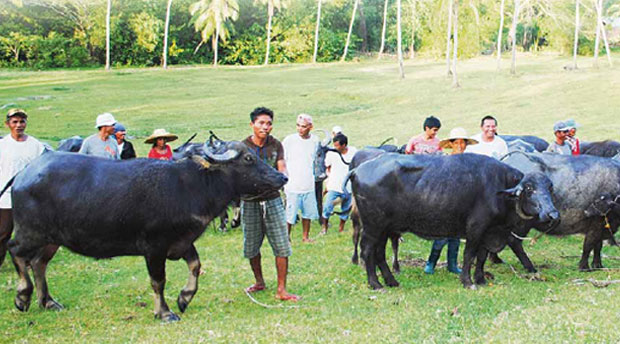
Farmers in barangay San Jose in Mabini town, Bohol show off their crossbred carabao. They want their barangay to be known as the “crossbred carabao capital” in the Visayas to underscore their success in improving their native carabaos for more benefits. (INQUIRER PHOTO)
President Carlos P. Garcia, Bohol—Worry not about the country’s beast of burden. Though threatened by the Filipinos’ fondness for “carabeef,” the fate of the carabao is not ending up in slaughterhouses, according to an official of the Philippine Carabao Center (PCC) in Central Visayas.
“We are improving the breed of native carabao… [by] crossbreeding them with the purebred Murrah (curled horn) buffalo,” said Dr. Caro Salces, director of the PCC at Ubay (Bohol) Stock Farm.
The Murrah buffalo are the “dairy type” and yield 4 to 6 liters a day, with the best of their kind producing more than 12 liters a day during peak season.
On the other hand, the native carabao are the “swamp type”, noted for draft power but not for milk production because they yield an average of only 1.2 liters a day.
“Over time, our native carabao will attain the qualities of a purebred. As such, farmers will not lead them to slaughterhouses but to milking barns,” Salces said.
The PCC official accompanied the Inquirer recently to this island town (population: 28,000) in Bohol province to see the agency’s efforts in preserving the native carabao.
“We have made our town a sanctuary of the native carabao,” President Calos P. Garcia Mayor Tesalonica Boyboy said.
The municipality has signed a memorandum of agreement with the PCC for the conservation, improvement and use of the native carabao.
The PCC at Ubay has also given 13 quality native carabao bulls to service the females of the 772 carabao owned by local farmers.
continuous breeding
“We are selecting the best from the male and female animals for continuous breeding,” said Gaudencio Lagura, municipal agricultural officer.
In barangay (village) Busiao, Desiderio Dumaplin and his wife, Liselle, are proud that their native carabao had borne a calf, ensuring the continuity of the local breed.
“We named it Landa. She was born when Super Typhoon Yolanda whipped our province,” Dumaplin said. “She will not be slaughtered. She is beautiful and will help us.”
Vanishing herd
According to the PCC, the carabao, the beast of burden that has helped farmers provide food for generations of Filipinos, was introduced by the Chinese between 300 BC and 2000 BC.
Records from the Philippine Council for Agriculture and Aquatic and Natural Resources Research and Development showed that the carabao population in the country in 2008 was 2.34 million heads, down from 2.82 million in 2007.
The 2013 inventory in 2013, according to the Bureau of Agricultural Statistics, was 2.88 million heads, or 1.62 percent lower than the 2012 level.
In 1962, the country had 3.5 million heads of carabao but the figure went down to 2.83 million in 1980 and 2.76 million in 1992.
At present, many livestock auction markets in the country are laden with carabao for sale. PCC officials in northern Luzon recently raised the alarm on the slaughter, citing the dwindling population in Pangasinan province.
The provincial government has enacted an ordinance regulating carabao slaughter to preserve the local breed.
Republic Act No. 7307, or the Philippine Carabao Act of 1992, mandated the establishment of the PCC as an attached agency of the Department of Agriculture.
The PCC headquarters and gene pool are based in the Science City of Muñoz, Nueva Ecija province.
“The native carabao then was declining in size and weight,” said Dr. Libertado Cruz, former PCC executive director.
“Among other factors [of the dwindling population], there was no strong breeding program to improve its breed. The good males were being castrated, leaving the task of propagating its kind to inferior bulls,” he said.
Cruz said the PCC had strong and working programs for carabao development. Among these are genetic improvement, carabao-based enterprise development, social training for farmers and research and development.
Cruz retired on Jan. 9 after 20 years as PCC head. His deputy, Dr. Felomino Mamuad, was appointed officer in charge and is continuing the projects.
Carabao breeds
Since 1994, the government has imported more than 5,500 American, Murrah, Brazilian and Italian buffalo so that these can be used to develop better carabao breeds. The animals were distributed as institutional herds to the 13 PCC stations and entrusted to farmer-beneficiaries for the incubator dairy modules.
The PCC’s upgrading of the native carabao program is carried out mainly through bull loans, artificial insemination and, to some extent, embryo transfer technology, or what is generally known as a test tube procedure.
The offspring of the crossbreeding are called crossbred carabao, but farmers prefer to call them buffalo to differentiate them from the native carabao.
In San Agustin town, Isabela province, PCC records counted more than 2,000 crossbred carabao.
Mayor Virgilio Padilla has adopted carabao development as the banner program of his administration, aiming to make his town the crossbred carabao capital of the country.
San Agustin holds the annual Nuang Festival in which the crossbred carabao are paraded and the best of them selected for an array of titles—biggest, best milk producer, fastest, most intelligent, best bull and most beautiful.
Not to be outdone, farmers in barangay San Jose in Mabini town, Bohol, want their village to be recognized for raising crossbred carabao to highlight their efforts in upgrading the native stock. They now have 250 crossbred carabao, with only 15 natives remaining in the village.
Disclaimer: The comments uploaded on this site do not necessarily represent or reflect the views of management and owner of Cebudailynews. We reserve the right to exclude comments that we deem to be inconsistent with our editorial standards.




